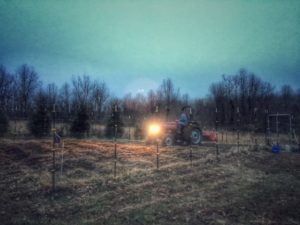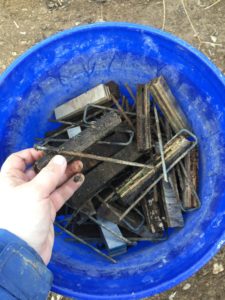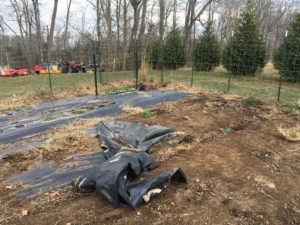
There are days I find myself wishing that things came easy. Let’s face it, in a perfect world, our Pinterest dinner would always turn out exactly as the picture. The food would always arrive to the table on time and without complaint. In fact, it would be exactly what everyone wanted… every time. The family would savor every bite and fall over themselves with gratitude. Then, the dishes would be quietly gathered and magically cleaned by kitchen fairies as they sang a whimsical tune. Oh a girl can dream, can’t she? We all know dinner doesn’t resemble a Disney film. It requires preparation and effort. Don’t get me wrong, there are times to “wing it.” But a steady diet of spontaneity can become exhausting. Let me explain further by taking you to the garden.
One may assume that simply because the growing season is over, the work is done. Nothing could be further from the truth. I didn’t think much about winter preparation until I had neglected it. As I’ve shared with you before, the first few years were a HUGE learning curve. I didn’t see the error of my ways until the third year. At that point, I began to notice that the garden wasn’t thriving like it had the first year. The plants seemed smaller and were becoming more prone to disease. My response became panicked as I tried several things to improve the garden without success. It wasn’t long before I found myself at the feet of my wise Gardening Jedi. In the fall, Brenda and I will text each other pictures of our canning adventures. It’s a cross between a recipe exchange and a victory dance. It’s usually late at night since both of us are “night canners.” She is so encouraging and always trying something new! After a little back and forth, she threw this at me: “Tomorrow’s going to be a nicer day. It’s about time to put the garden to bed.” In that moment, I really didn’t know what she meant. I decided to turn to google for more information. Suddenly, the lights started turning on. Preparation for winter was important and I wasn’t doing anything! I would love to tell you that I concocted a huge plan in order to remedy the situation. I didn’t. The first year’s plan was simple: hook up the trailer, buy some compost, and till it in. (A quick note: Let me pause to thank my gracious, and amazing husband for the back-breaking work he did unloading that compost and tilling it in – sweetie, I couldn’t do this without you!) This simple start changed everything. The following year, we were back! The plants were larger and yielded three times as much as the previous year.
 Over time, my “bed-time” regime expanded. This year, it included pulling out old plants, gathering black plastic and supportive tools (staples, trellis, & tomato cages), pruning berry bushes, covering the strawberry plants, emptying the water tanks, and tilling the soil. Winter preparation really depends on a gardener’s preferences and the garden’s needs. There are so many different strategies people use. Experienced gardeners may seed their fields with winter cover crop. This strategy improves organic matter and soil fertility along with reducing pests and soil erosion. Other gardeners will use old fashioned techniques taught by their grandparents. I remember one person telling me that they cover their soil with newspaper and cardboard to attract worms for soil irrigation. I attempted this last year only to have the wind send cardboard into the neighbor’s yard. (Sorry Jack!) Whatever preparation techniques you use, the goal should be simple: improve the soil for the years to come.
Over time, my “bed-time” regime expanded. This year, it included pulling out old plants, gathering black plastic and supportive tools (staples, trellis, & tomato cages), pruning berry bushes, covering the strawberry plants, emptying the water tanks, and tilling the soil. Winter preparation really depends on a gardener’s preferences and the garden’s needs. There are so many different strategies people use. Experienced gardeners may seed their fields with winter cover crop. This strategy improves organic matter and soil fertility along with reducing pests and soil erosion. Other gardeners will use old fashioned techniques taught by their grandparents. I remember one person telling me that they cover their soil with newspaper and cardboard to attract worms for soil irrigation. I attempted this last year only to have the wind send cardboard into the neighbor’s yard. (Sorry Jack!) Whatever preparation techniques you use, the goal should be simple: improve the soil for the years to come.
For those of you who read the last post, you’ll remember the discussion about winter being a time of rest rather than loss and death. Even before the first frost, creation is preparing for rest (Sabbath). If creation carries the nature of God (Romans 1:20), it explains a lot when we look at God’s instructions to the Israelites regarding Sabbath. God’s heart wasn’t to confine them but provide an opportunity to restore them. That was always His plan! In Exodus, He offers the following directions: 1) Keep the Sabbath Holy (consecrated – time set apart), and 2) to gather enough food to prepare for it. There is no hiding God’s intentionality here. Sabbath requires us to consciously plan and prepare for designated time away from our busy lives.
 As I began putting this current blog series together, it didn’t dawn on me that I would release it in the midst of Advent. Growing up, I wasn’t exposed to the Christian Church calendar like many of my liturgical brothers and sisters. In recent years, I’ve been honored to rub shoulders with those who have. According to the Christian Calendar, Advent begins each liturgical year followed by the Christmas season. Advent starts on the fourth Sunday before Christmas Eve. The Christmas season begins on December 24 and ends 12 days later on January 6 (Epiphany). This is where we get the 12 days of Christmas. Traditionally, the early church Fathers saw Advent as the time to reflect on the coming of Christ as a babe. Advent is focused on preparing one’s heart for Christ. It is meant to symbolize the “waiting” Israel did in anticipation for the Messiah. Advent is also the call for people to prepare for the second coming of Christ. It is the season to slow down in order to foster hope and anticipation for the coming Kingdom. How counter cultural is this? Seriously! Most people I encounter during Christmas are trying to juggle their normal responsibilities with the pressures of the holiday: school parties, work parties, dinners, gift exchanges, decorating, shopping, baking, and pictures with Santa. I nearly had a panic attack trying to drive past the mall today. I wasn’t even trying to go shopping! Let me just say, very few people are offering “holiday greetings” as they cut each other off trying to get into the parking lot. The hustle and bustle of our society’s commercialized Christmas experience seems to scream in the face of Advent and Sabbath.
As I began putting this current blog series together, it didn’t dawn on me that I would release it in the midst of Advent. Growing up, I wasn’t exposed to the Christian Church calendar like many of my liturgical brothers and sisters. In recent years, I’ve been honored to rub shoulders with those who have. According to the Christian Calendar, Advent begins each liturgical year followed by the Christmas season. Advent starts on the fourth Sunday before Christmas Eve. The Christmas season begins on December 24 and ends 12 days later on January 6 (Epiphany). This is where we get the 12 days of Christmas. Traditionally, the early church Fathers saw Advent as the time to reflect on the coming of Christ as a babe. Advent is focused on preparing one’s heart for Christ. It is meant to symbolize the “waiting” Israel did in anticipation for the Messiah. Advent is also the call for people to prepare for the second coming of Christ. It is the season to slow down in order to foster hope and anticipation for the coming Kingdom. How counter cultural is this? Seriously! Most people I encounter during Christmas are trying to juggle their normal responsibilities with the pressures of the holiday: school parties, work parties, dinners, gift exchanges, decorating, shopping, baking, and pictures with Santa. I nearly had a panic attack trying to drive past the mall today. I wasn’t even trying to go shopping! Let me just say, very few people are offering “holiday greetings” as they cut each other off trying to get into the parking lot. The hustle and bustle of our society’s commercialized Christmas experience seems to scream in the face of Advent and Sabbath.
So how do we promote Sabbath in the midst of Christmas? It’s simple really. It requires us to slow down and plan. There is no way around it. We need to hear the call of God to prepare our hearts and make room. Recently, I asked a few friends to offer their thoughts on this topic. My friend Julie recently began incorporating the Advent season into their family traditions. She offers a great perspective and practical ways her family sets time aside:
“For the past few years, I have been learning to celebrate the seasons of the liturgical calendar. In a few days, we will begin the season of Advent (December 3, 2017). Advent stems from the Latin word for ‘coming.’ It is a season of joyful hope in which we prepare to celebrate the first coming of Christ at Christmas as we expectantly wait for His second coming. The season of Advent invites us to quiet our hearts, quiet our lives, and prepare ourselves to be ready for Christ’s return. The most challenging part of this season is that the secular culture is doing just the opposite of this during this time of the year. A few practical things I have done to give us the ability to enter into the spirit of Advent include finishing (almost all of) my shopping before Advent begins, organizing our decorations right after Thanksgiving, keeping our activities to a select few important ones, and generally trying to tackle as much ‘Christmas busywork’ as I can before Advent starts. In the season itself, I have both personal devotions as well as ones we do as a family. Every year, our church provides an Advent devotional that I read. I choose a book or two for spiritual development that I work through as well. This year, we are beginning the family tradition of the Jesse tree. We decorated a tree in the colors of Advent – purple and pink. Every day we will read from Scripture and hang a corresponding ornament on our tree. The Jesse tree takes you from Creation to the birth of Jesus and focuses on the lineage from Adam to Christ. It’s a great way to teach our kids salvation history and how God was working from the beginning of time to bring about the Incarnation.”
Before you start down the road of inadequacy or comparing yourself to Julie, hear her heart in this. Their process didn’t begin here. Over time, their family gradually adopted a plan specific for them. It is counter cultural. It is meant to put Christ first. I love the call of the evangelical Church to keep “Christ in Christmas” and remind others that “Jesus as the Reason for the Season,” but how are we doing that? We won’t find rest by reciting good mantras. Being counter cultural requires us to invite Jesus into our plans.
I’ll leave you with this thought – Don’t become overwhelmed. This isn’t another “to do” list. Just like my first plan that prepared the garden for rest, start small. This is a moment to invite the Lord into your plans.
I invite you to take 10-15 minutes today and ask the Lord –
- How are you calling me to be more intentional? What does it look like for me to slow down and take time to receive you this Advent and Christmas season?
- Is there something you would have me stop or start to prepare the soil of my heart for the next season of my life?
I like the idea of the Jesse Tree. I don’t think that I have every encountered the Jesse Tree. What a great way to introduce salvation history to young people. Thank you for connecting Advent to your gardening call. It is amazing how you find in your creational interactions God’s workings. Yesterday some children in our church and my family went to see the new movie The Star which is a retelling of the Christmas story from the perspective of the animals (non-human creation). It is a reminder of our connection to creation and how Christ has come o redeem everything and that creation itself has a story to tell about Christ.
Rodney – Julie is always full of great ideas! I love hearing about all the ways people are teaching their kids about the Christmas story!
So good! Spending time with Jesus and these questions ❤️
Lashay – I miss seeing you my friend! Let’s catch up with coffee soon 🙂
This was WONDERFUL as my Dad would say! Thanks for sharing your gift of writing! Being still and slow is not natural for me. However, lately GOD keeps placing reminders such as your article to SLOW down!! I am really trying to be more intentional to be quiet/slow down this Christmas season. Thanks for sharing!
Greg – thanks for sharing! You know, slowing down is not easy for me either. I heard it said that the spirit of the age is busyness and rage. It really is counter cultural to pause and respond vs. react.
Blessings brother!!